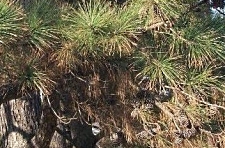Wildlife - Species

Loblolly Pine (Pinus taeda)
Description
Loblolly pine belongs to the pine family (Pinaceae). It is a large tree, reaching heights of 46 meters (150 ft). The leaves occur in bundles of three and are about 15 cm (6 in) long. The cones have stout prickles on them.
Preferred Habitat and Biology
Commercial stands of loblolly pine are found from Maine south to Florida and west to Texas, but the pine naturally occurs in Delaware, Maryland, throughout the southeast (North Carolina south to Florida and west to Mississippi River), Arkansas and Texas. The trees grow on a wide variety of soils, ranging from the poorly drained soils of the Coastal Plain to the better-drained soils of the Piedmont region. In the ACE Basin, both planted and natural stands of loblolly pine grow in moderately to poorly drained areas.
Loblolly pines grow best in soils with poor surface drainage, a deep surface layer, and a firm subsoil. The pine populations are maintained by sexual reproduction. The trees begin to produce seeds before the tenth growing season and continue for another 30 years or so. The development of a viable seed crop requires two growing seasons from the time of flower bud initiation. During the first year, flower buds grow during midsummer, reaching maturity during the winter. The following spring, the female flowers are fertilized by airborne pollen, and the seeds reach maturity in early October. The seeds are disseminated by the wind, and most of them are only carried 30 to 90 meters (100-300 ft) away from the parent tree. In most cases, less than 20% of the seeds reach the seedling stage. Many are eaten by birds and rodents before they germinate, and others die shortly after germination due to such factors as inadequate water supply or competition from faster-growing vegetation.
Species Significance
The seeds of pines constitute more than 50% of the diet of three birds: the red crossbill, Clarke nutcracker, and white-headed woodpecker. There are also quite a few species of other birds and mammals that feed on pine seeds. Pine needles are consumed by grouse and several browsers such as the white-tailed deer. Northern mammals, such as the porcupine, use the bark and wood as food. Pines are also a valuable cover for wildlife. They are a favorite roosting site for robins during migration and commonly provide nesting sites for bald eagles and other raptors. This species is very common throughout it range and is increasing due to plantings by landowners.
References
Martin, A.C., H.S. Zim, and A.L. Nelson. 1951. American wildlife and plants: A guide to wildlife food habits. Dover Publications Inc., New York, NY.
Radford, A.E., H.E. Ahles, and C.R. Bell. 1968. Manual of the vascular flora of the Carolinas. The University of North Carolina Press, Chapel Hill, NC.
Wenger, K.F. 1958. Silvical characteristics of loblolly pine. Station Paper No. 98. Southeastern Forest Experiment Station, Asheville, NC.
